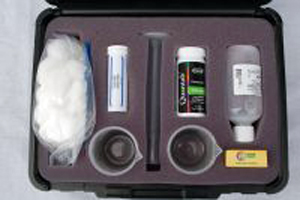SCAT Kit Surface Contamination Analysis Test Kit

- Designed to Identify & Quantify Water Soluble Chemical Contamination.
-
OverviewSCAT Kit (Surface Contamination Analysis Test Kit) provides the necessary equipment to analyze surfaces for the presence of chlorides, soluble ferrous salts, and alkaline/acidic contaminants.The protective coatings industry is recognizing the role of these "unseen" contaminants in causing premature corrosion and untimely coating failures such as undercutting, metallic corrosion, accelerated degradation of paints, and blistering and premature failure of coatings and linings in immersion service.SCAT Kit is simple to use and offers the convenience of field portability, while providing the reliability of laboratory analysis. The kit contains a graduated cylinder, beakers, tweezers, water demineralizer, cotton swabs, chloride ion titrator indicator strips, ferrous ion indicator strips, pH paper, ruler and instructions. All items are packaged in a lightweight rugged durable carrying case.SCAT Kit (Surface Contamination Analysis Test Kit) provides the necessary equipment to conduct analyses of surfaces for the presence of chlorides, soluble ferrous salts, and alkaline/acidic contaminants.
Evaluation of Chloride and Ferrous Ion Results
The charts on the test strips give the concentration of chloride and ferrous ion as parts per million (ppm) which, for aqueous solutions, is the same as micrograms/milliliter (µg/ml). Therefore, the actual amount of ion extracted is obtained by multiplying the ppm by the volume of water used. For example, if 10 ml of water was used, and the Quantab read 62 ppm, then 620 µg of chloride were extracted. A microgram (µg) is one millionth of a gram; 454 grams equals 1 lb.By knowing the area swabbed the concentration can now be determined by simple division. If, for example, in the above case, a 6 cm x 9 cm (54 cm2) area was used the chloride concentration is 620 micrograms/54cm2= 11.5 micrograms/cm2. Furthermore, this can be convened to milligrams/meter2 by multiplying by 10. (11.5 µg/ cm2 x 10 = 115 mg/m2).If a 6 " x 6" area (15 cm x 15 cm) and 22.5 ml of water are used, the concentrations determined in ppm are identical to milligrams/meter2, with no further calculations needed.
pH
pH is determined with the pH paper included in the kit. The pH can be determined on the water extract obtained in the above section by dipping the strip into the extract and comparing the resulting color with that on the color scale included with the paper. Alternately, the pH of the steel surface itself can be determined by placing a small strip of the paper on the surface (e.g., 1-1/2 ") and moistening it with 1 or 2 drops of deionized water, making sure that the pH paper is in intimate contact with the steel surface. Again, compare the resulting color with the color chart. It is always a good practice to check the pH of the water used, since this may or may not be 7 (neutral).
-
Technical Data
-
Chloride Detection Limit: approximately 40 PPM
-
Ferrous Ion Detection Limit: approximately 3 PPM
-
Demineralizer Cartridge Life: good for approximately 3000 ml of water
-
pH Paper Range: 4 - 9, verified by color scale
Scat Kit Contents
-
Graduated Cylinder
-
Beakers
-
Tweezers
-
Water Demineralizer
-
Cotton Balls
-
Chloride Ion Titrator Indicators
-
Ferrous Ion Indicators
-
pH Paper (range 4 - 9)
-
Ruler
-
Instructions
-
Carrying Case
-
-
Operating Procedures
-
Use a ruler and chalk or pencil to measure out a convenient area, in centimeters (cm), on the surface to be tested. A 10 cm x 10 cm (100 cm2) area has been found to be convenient, but other sizes will do. (1 inch = 2.54 cm).
-
Use only distilled or deionized water to perform the test. The portable demineralizer included in the SCAT Kit is a convenient way of obtaining this water. Simply pour tap water into the plastic bottle, attach the demineralizer cartridge in the direction indicated, invert, and squeeze out the desired amount of water. The cartridge can be used until the blue color turns brown, as indicated on the side of the cartridge. Once this occurs, discard the cartridge and replace. Each cartridge should be good for approximately 3000 ml of water.
-
Using the graduated cylinder, measure out an exact volume of deionized water into one of the small plastic beakers. At least 10 ml will be required.
-
Dampen one of the cotton balls in the beaker of water and thoroughly swab the measured area, using the tweezers. After swabbing, swirl the cotton ball in the water and squeeze it against the side of the beaker each time. Repeat this procedure at least 4 times, then place the cotton ball in the beaker of water. Use a fresh cotton ball to dry off the test area, and place it in the beaker as well.
-
Stir or swirl the contents of the beaker containing the water and cotton balls for at least 2 minutes to assure thorough mixing.
-
Determine the chloride level by placing the lower end of one of the Quantab test strips in the water in the beaker.
-
Allow the water to wick up and saturate the test strip. Saturation is achieved 2 minutes after the yellow strip across the top of the column begins to turn dark blue. This takes about 20 minutes.
-
The presence of chlorides is indicated by a color change of the tan scale to white. Note the scale number at the top edge of the white, and compare it to the calibration chart enclosed with each Quantab bottle to obtain the concentration of chloride.
-
Ferrous ion can be determined on this same extract by using the Ferrous Ion Test Strips. Simply moisten a test strip in the extract and compare the color change to the color-coded chart on the container label.
-

